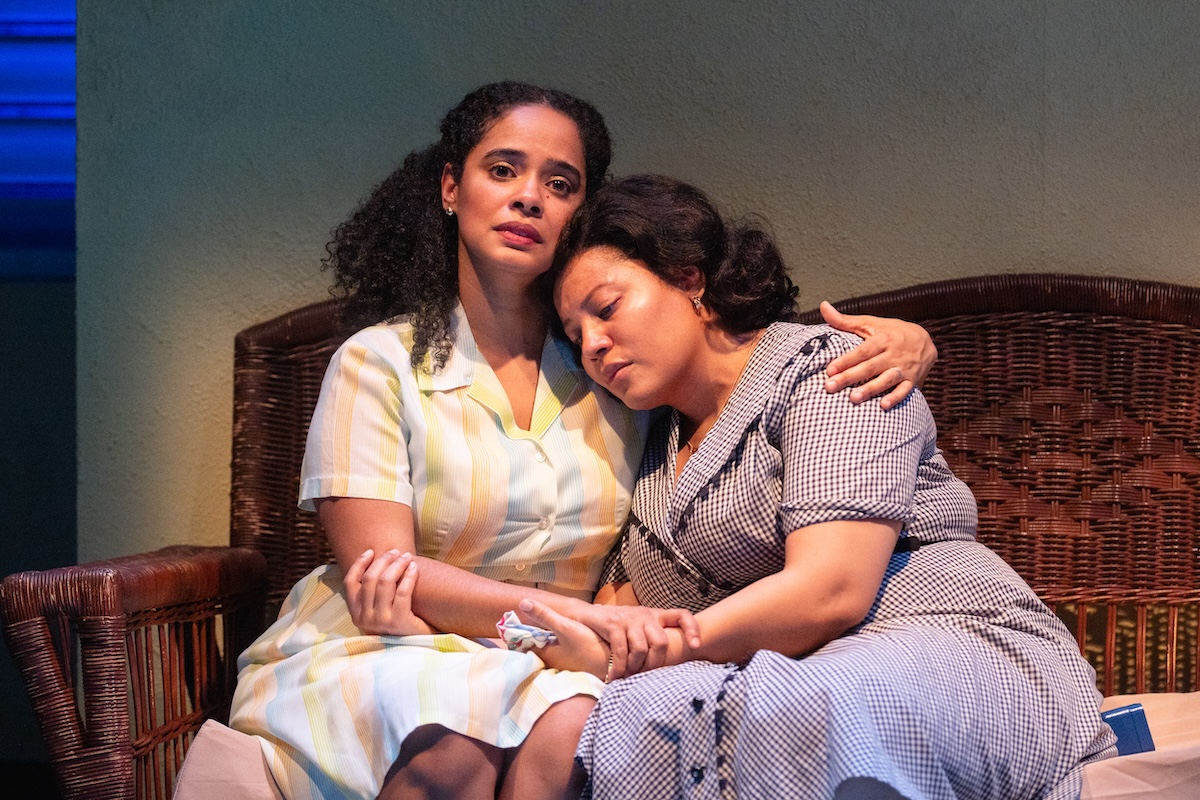City Lit in the Second Stage of Life

Rob Howard, Nadirah Host,
and Marsha Estell in
My Man Bovanne
A little more than a year ago, City Lit Theater stood on the brink. After 20 years of producing high-quality literary adaptations for the stage, the company’s coffers were empty, and debts were accumulating faster than the theater could pay them off.
For several seasons, the company had been generating just enough income to keep going. Then last year, the theater’s holiday show–an annual adaptation of one of P.G. Wodehouse’s Bertie and Jeeves novels–didn’t generate as much revenue as hoped.
“We had to suspend operations,” artistic director Mark Richard gravely recalls. As a result, City Lit dismissed its staff, closed its office, and both Richard and managing director Page H. Hearn found day jobs to pay their own bills while they worked to pay off the theater’s debt and tried to decide what to do next.
“These difficulties always hover over small theaters,” says Richard. “It is the downside of how vibrant the Chicago theater scene is. There is tons and tons of activity–and that means it is more and more difficult to stay visible.” And stay afloat.
It was a sad end, or so it seemed, for a company born in 1979 when a trio of young theater artists, Arnie Aprill, David Dillon, and Lorell Wyatt, founded City Lit in a less crowded, less vibrant theater scene. Aprill in particular had spent a great deal of time knocking around the young off-Loop theater movement, working for a time with Paul Sills and the legendary Body Politic. Using techniques borrowed from Sills and others, Aprill began adapting classic short stories for the stage.
These early adaptations were performed concert-style with a small group of actors performing different roles and sharing the narration. Performances took place in spaces not usually associated with theater–say a common area at IIT, or the Three Arts Club.
It was a heady time for Chicago’s off-Loop scene. New theaters were popping up all the time, and, as Richard remembers, “You could put all your money in your production, invite the press. They’d show up and if they liked the show, the reviews came out in a timely fashion and the phones rang.”
[[pg]]

in W. Somerset Maugham’s
The Outstation, part of
20/20 Hindsight:
20 Years, 20 Stories
After several years of producing theater this way, City Lit made the leap from staged readings to full productions with Aprill’s 1985 version of A Tale of Two Cities.
“Originally that was supposed to be a co-production with Pegasus Players,” recalls Richard, who joined the company during this production, “but then it was put on hold when Pegasus moved to Truman College. And then, for reasons I do not know, [the show] didn’t happen at all–but Arnie [Aprill] already had a full cast, was already in rehearsal, so we staged the show in the Stormfield Theater.”
The production proved to be City Lit first real hit, and soon the group became well-known as much for full productions of literary works as for their chamber performances. The years that followed brought more hits, most notably Aprill’s 1989 adaptation of Linda Barry’s novel The Good Times are Killing Me.
“That was a big breakout hit for us,” Richard recalls. “It ran for a year, first at Live Bait, where it first opened, then at Body Politic, and finally at the Halsted Street Theater Center.” During this time, the company was gaining momentum and, more importantly, increasing its credibility with the press and the public.
Great momentum brought great advantages. First, City Lit had a regular space–Live Bait shared its stage–and an unofficial ensemble of talented theater people began to grow. “We had a loose family of folks back then,” Richard remembers, “who would meet every weekend. It was like some weird Quaker ritual. We would pass books around and read to each other.”
Aprill and Richard were both attracted to the fiction of Raymond Carver and had been trying to get permission to do stage versions of his work, finally getting stymied by an independent filmmaker who owned the rights to the writer’s prose. Richard then looked at Carver’s poetry and, at one of those meetings, introduced that aspect of Carver’s work to the group. Sensing the underlying narrative in Carver’s poetry, Richard wrote to Carver’s estate (administered by Carver’s widow, poet Tess Gallagher) and quickly landed the appropriate rights. Richard then began working on a two-hander that became The Hero’s Journey.
“[When] we opened it was part of a poetry and performance series at Live Bait. We thought this was going to be the tiniest, riskiest experiment. And it just took off.” Originally scheduled for a four-week run,
[[pg]]
With Richard now at the helm of the company, City Lit now mounted a string of successive shows, including their first two Wodehouse hits, Right Ho, Jeeves and The Code of the Woosters, and a very jazzy adaptation of John Clennon Holmes’ The Horn, which was produced at Steppenwolf.
By this time, the late ’90s, the direction of Chicago’s theater scene had changed. The competition was keener; it was getting harder to get and keep the public’s attention. “These days,” Richard adds, “the press may or may not show up and the review may or may not run for several weeks. Now, the financial burden is much higher on theaters. Much more money must be spent on marketing, and every dollar spent on marketing is taken away from the production.” The economics caused City Lit to suffer several less-than-stellar seasons financially, and after a disappointing revival of Right Ho, Jeeves, City Lit was on the ropes.
“At least we didn’t do what a lot of theaters do. We didn’t put all out chips on one last production hoping to hit on great home run, or what ever the mixed metaphor is,” Richard jokes dryly. “We just stopped for awhile and paid down our debts.” Then one evening, Richard and Hearn decided to get together after work and figure out what they were going to do with City Lit. “We were talking about what we wanted, if anything, to do with City Lit, when we felt a tap on our shoulders. It was Ron Parsons [founding member of the Onyx Theater].”
It turned out that Parsons and his theater were leaving their space in the Edgewater Presbyterian Church. “Why don’t you talk to them?” Parsons asked. For years the Edgewater Presbyterian Church and school complex had also been a home to off-Loop theaters. Pegasus, the Commons Theater, Shakespeare’s Motely Crew, and most recently Onyx had all produced shows in the storefront-style theater that had been carved out one of the building’s classrooms.
Quickly, Richard and Hearn put in competitive bids for the space. Landing it, they reasoned, would not only give them inexpensive office space and regular full-time use of a stage, but would also give coherence to City Lit’s strategy–to produce more chamber-style performances–for both schools and the public alike.
Last fall, City Lit’s application was accepted. “From the moment we met with the Pastor there, Gordon Butcher, things have been looking up for us,” Richard said, adding that for their first production in their new space, the group will celebrate the company’s 20th anniversary by staging an epic, four-week retrospective of their work, called 20/20 Hindsight. “I figured, this our 20th year and we are not dead. Let’s take a whack at giving a representative sample of all of [our work],” he said.
Following 20/20 Hindsight, City Lit will next produce their version of Alice in Wonderland, and, after that, an adaptation of A Turn of the Screw, to open in early October.
“It fights nicely with Halloween,” Richard says. “Over and over I keep having these wonderful experiences in this new space. The front door of the theater is open and one day I went in and found these six little kids from the school playing hide-and-seek. When I walked in they started asking me about the room: ‘What kind of space is this?’ ‘What is a theater?’ ‘What do we do in here?’ And talking to them I couldn’t wait to put on a production for them and show them how wonderful live theater could be.”










